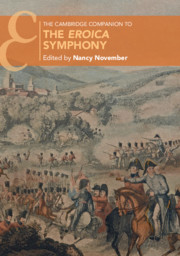Book contents
- The Cambridge Companion to the Eroica Symphony
- Cambridge Companions to Music
- The Cambridge Companion to the Eroica Symphony
- Copyright page
- Contents
- Illustrations
- Musical Examples
- Notes on Contributors
- Eroica Chronology, 1770–2020
- Acknowledgements
- Introduction
- Part I Context and Genesis
- 1 Beethoven and Heroism in the Age of Revolutions
- 2 Beethoven’s ‘Watershed’? Eroica’s Contexts and Periodisation
- 3 The Symphony in Vienna and Abroad around 1800
- 4 Genesis and Publication of the Eroica
- Part II Analytical Approaches
- Part III Reception
- Further Reading
- General Index
3 - The Symphony in Vienna and Abroad around 1800
from Part I - Context and Genesis
Published online by Cambridge University Press: 04 June 2020
- The Cambridge Companion to the Eroica Symphony
- Cambridge Companions to Music
- The Cambridge Companion to the Eroica Symphony
- Copyright page
- Contents
- Illustrations
- Musical Examples
- Notes on Contributors
- Eroica Chronology, 1770–2020
- Acknowledgements
- Introduction
- Part I Context and Genesis
- 1 Beethoven and Heroism in the Age of Revolutions
- 2 Beethoven’s ‘Watershed’? Eroica’s Contexts and Periodisation
- 3 The Symphony in Vienna and Abroad around 1800
- 4 Genesis and Publication of the Eroica
- Part II Analytical Approaches
- Part III Reception
- Further Reading
- General Index
Summary
Viennese courtly Kapellen were in decline by the time Beethoven began his career as a symphonist, with the result that one of the most important contexts for eighteenth-century symphonies was no longer available to the young generation of composers. This decline, along with various other developments in Viennese musical life during Beethoven’s lifetime, led to a reconfiguration of the symphony’s role. Public, rather than private concerts became the main platform for symphonic performance in Vienna and abroad by 1800. The organisation of Vienna’s concert life meant that symphonies were increasingly conceived as grand, individualistic works, rather than routine household entertainment music. Furthermore, select members of the Viennese aristocracy, including some of Beethoven’s supporters, continued to cultivate symphonies, with the result that Beethoven was better placed than some of his contemporaries for securing the performance and subsequent publication of symphonies. This chapter contextualises Beethoven’s first three symphonies within the broader culture of symphonic composition and performance at the turn of the nineteenth century.
Keywords
- Type
- Chapter
- Information
- The Cambridge Companion to the Eroica Symphony , pp. 43 - 60Publisher: Cambridge University PressPrint publication year: 2020
- 1
- Cited by

